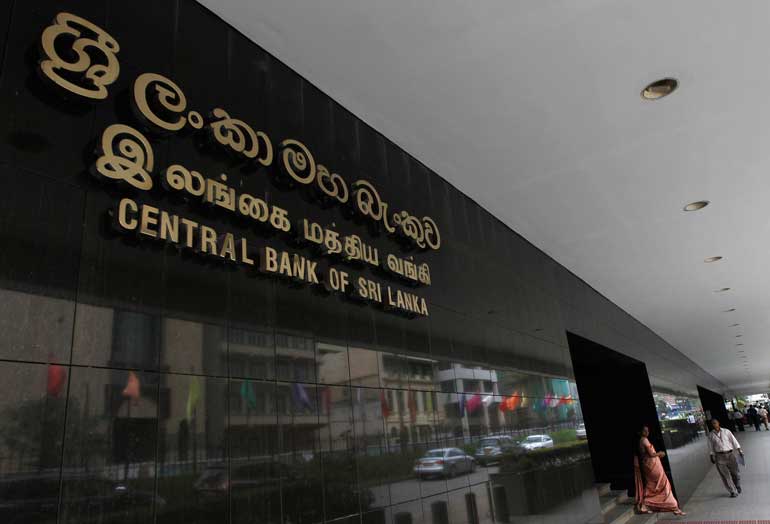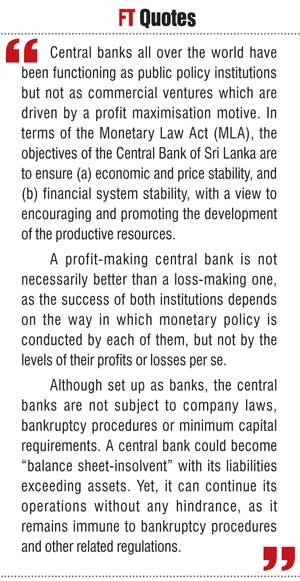Wednesday Apr 17, 2024
Wednesday Apr 17, 2024
Thursday, 19 May 2016 00:00 - - {{hitsCtrl.values.hits}}


By Prof. Sirimevan Colombage
Raising public awareness, several insightful articles on the recent losses of the Central Bank written by a prominent economist appeared in Daily FT during the last couple of days. The issue is that the Central Bank incurred losses for the third consecutive year in 2015 resulting in a fast depletion of the bank’s capital. It is alleged that the continuously loss-making Central Bank is no better than Sri Lankan Airlines. The writer further argues that when a central bank becomes bankrupt with a negative net worth due to continued losses, the public as the owners of the central bank are required to recapitalise the bank at great costs.
Central Banks differ from commercial enterprises
Central banks all over the world have been functioning as public policy institutions but not as commercial ventures which are driven by a profit maximisation motive.
In terms of the Monetary Law Act (MLA), the objectives of the Central Bank of Sri Lanka are to ensure (a) economic and price stability, and (b) financial system stability, with a view to encouraging and promoting the development of the productive resources.
Hence, one could argue that it is inappropriate to equate the Central Bank with a commercial enterprise like a loss-making airline, and to conclude that the bank would go bankrupt with its continuous losses. Admittedly, empirical evidence suggests that a stronger capital base of a central bank helps to carry out its functions smoothly without compromising its independence. But it does not mean that central banks should drive their monetary policy operations keeping profit motive in the forefront undermining its monetary policy objectives which are of broader national interest.
Central banking beyond profits/losses
While appreciating the point that a stronger capital base enables a central bank to act more independently without resorting to government funds, a different line of argument that one could put forward is that the core objective of the central banks is to achieve price stability through monetary policy operations but not to make profits.
In analysing the effectiveness of a central bank, therefore, due recognition must be given to its monetary policy operations going beyond its profits/losses in accounting sense. A profit-making central bank is not necessarily better than a loss-making one, as the success of both institutions depends on the way in which monetary policy is conducted by each of them, but not by the levels of their profits or losses per se.
The monetary policy adopted since 2012 until about mid-2015 had adverse effects on the Sri Lankan economy. The Central Bank reduced its policy (interest) rates continuously while defending the rupee at an overvalued exchange rate during that period. Such a policy stance had led to create excess liquidity in the market, overheating the economy with resultant demand pressures as reflected in the continuous rise in import demand and core inflation even now.
It is only during the last few months that the Central Bank has allowed greater flexibility in the exchange rate and interest rates so as to respond to market realities. Accordingly, the depreciation of the exchange rate and the rise in market interest rates would help to rectify macroeconomic fundamentals which had been in disarray for a long time.
Cost of monetary operations inevitable
A central bank’s profit/loss is partly an outcome of its monetary policy actions encompassing policy rates, open market operations, statutory reserve ratio, exchange rate and foreign currency investments. The bank’s decisions on such operations are governed by the prevailing monetary policy stance rather than by profit maximisation motive, as mentioned earlier. Inevitably, monetary policy operations may result in losses at times.
Certain favourable effects of a prudent monetary policy such as a stable financial system or a low inflation environment are beneficial from the societal point of view, but the internal financial effects of such underlying policy measures may ultimately get recorded as losses in the accounting statements of the central bank. Therefore, it might be unreasonable to discredit the Central Bank on such grounds without taking into account the wider macroeconomic effects.
No common capital adequacy norms
Being the monetary authority in charge of financial regulation and supervision, a central bank is required to maintain an adequate level of capital enabling it to function independently without resorting to government coffers for recapitalisation.
Universally, however, there is no common agreement on the optimal quantity of capital that should be maintained by a central bank. It is broadly accepted that central banks need to maintain risk-based, non-negative level of capital.
As per MLA, the required capital for the Central Bank is Rs. 15 million which may be increased up to a maximum of Rs. 50 billion. Its capital funds now stand at Rs. 50 billion which is the maximum level stipulated in MLA. The total amount of equity, however, declined from Rs. 115 billion in 2013 to Rs. 82 billion in 2014 and to Rs. 54 billion in 2015 due to the downward trend in reserves.
Nevertheless, the losses incurred by the bank which increased from Rs. 24 billion in 2013 to Rs. 32 billion in 2014 declined to Rs. 20 billion in 2015 reflecting an improvement in its finances.
Central banks cannot go bankrupt easily
When an unprofitable commercial venture like SriLankan Airlines finds it impossible to continue its business due to unsustainable debts, it would be declared bankrupt. This is hardly relevant to a central bank however much it is weak in terms of the conventional accounting standards.
Although set up as banks, the central banks are not subject to company laws, bankruptcy procedures or minimum capital requirements. A central bank could become “balance sheet-insolvent” with its liabilities exceeding assets. Yet, it can continue its operations without any hindrance, as it remains immune to bankruptcy procedures and other related regulations.
“Bankruptcy” is a legal status of an entity that cannot repay the debts it owes to creditors. So, an immediate question to be raised is, what debts does the Central Bank “owe”. Currency in circulation, deposits of commercial banks, other financial institutions and government are the major liabilities of the central bank.
The central bank is in an exclusive position having its biggest component of liabilities in the form of currency as the legal tender of the country issued by the bank itself. Hence, it is said as long as the notes and coins issued by a central bank are acceptable to the public as legal tender, it can never go bankrupt. However, there are a few exceptions in which central banks fail to function under extreme conditions. The Central Bank of the Philippines which was declared bankrupt in 1993 is such a rare case.
The comprehensive net worth of a central bank is greater than the net assets registered in its published balance sheet. The reason is that the published balance sheets do not capture intangible assets such as the franchise value of the monopoly right of the central bank to issue base money.
Whenever creditors decide to withdraw their deposits from the central bank in large scales, it can meet such demand by printing new currency at will. However, that does not mean central banks are free to issue unlimited amounts of currency which might lead to accelerated inflation, defeating the price stability objective. When the general price level rises rapidly, leading to ‘hyper-inflation’, the domestic currency would erode to the extent that it is rejected by the public. That is the limit faced by central banks in issuing new money.
Wrap-up
The Central Bank being the monetary authority of the country has broader obligations to fulfil in the interest of the national economy. When conducting its monetary policy operations focusing on national goals, it may incur unavoidable losses at times. In this context, it is unfair to bring the Central Bank into disrepute on such grounds disregarding the wider macroeconomic effects of its monetary policy operations.
Although such losses may adversely affect the financial strength of the bank in the short run, it has the ability to improve its net worth over the long run, given the bank’s prime position as the country’s monetary authority and the sole currency issuer. The implicit limit of currency printing in the extreme is refusal to accept currency by the general public which seems a remote possibility in the case of Sri Lanka at present.
“Seigniorage” or profit earned by the Central Bank by issuing currency is not reflected in its profit/loss account, but interest accrued through the securities exchanged for currency is reflected as profits, making it financially sound over time.
The financial strength of a central bank goes beyond the mere financial resources and includes risk transfer mechanisms such as the rules governing distribution of profits. The Central Bank claims that it has taken positive steps in these directions since 2015.
While recognising the need to maintain adequate capital so as to meet the potential risks and to safeguard independence, the performance of a central bank should be judged in terms of the effectiveness of its monetary policy operations rather than by narrowly looking at its profits or losses per se.
(The writer, an economist, academic and former central banker, can be reached at [email protected])